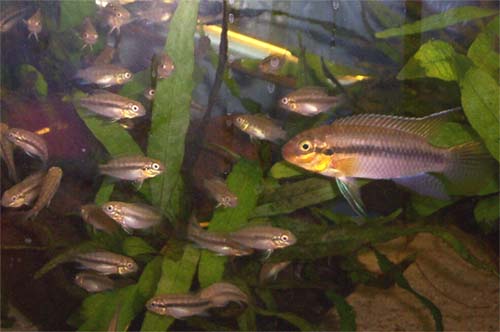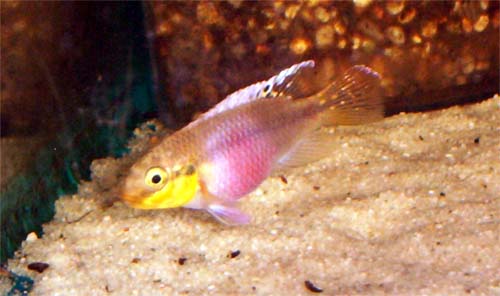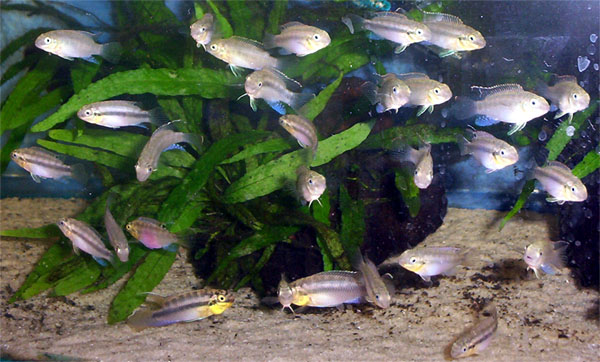Introduction

- P. subocellatus make great parents. This is an adult male with his growing fry.
Pelvicachromis subocellatus is another of the beautiful little cichlids from West Africa that are overshadowed somewhat by the common krib (P. pulcher). There are a couple of varieties available; this article is based on the less common “Moanda” rather than the more well-known “Matadi“.
Distribution & Availability
P. subocellatus is found in the rivers from Libreville (Gabon), eastwards and south to the western parts of The Democratic Republic of Congo. Unfortunately P. subocellatus is rarely found for sale in shops. Your best bet is mail order or from fellow hobbyists. Sometimes listed as yellow-cheeked krib or ocellated krib.
Description
Males – smaller than the common krib at around 8cm maximum size. The body shape is rather slender while the head is rounded. The front of the body and all of the head is yellow, fading to brown over the middle and rear of the body. A broad dark horizontal stripe may be visible depending on mood. The male’s caudal fin is slightly rhomboid and divided in two, the lower half is covered in subtle vertical stripes while the upper half is clear with a pink edge. The rest of the unpaired fins are like the lower part of the caudal.
Females – up to 6cm. Rather similar to the male but less slender. The caudal fin is rounder and the pelvic fins are rounded in the manner of all the females in this genus. Females exhibit a dramatic colour change when breeding. The belly becomes a brilliant pink surrounded by silver and black whilst the silver on the dorsal fin intensifies. The head is canary yellow. Altogether a stunning little fish.

Requirements
Needs slightly more specialised conditions than the common krib but is by no means a difficult fish to keep. Just make sure the water quality is first-rate and the pH and hardness are kept low. Suitable for a planted community tank of peaceful, soft water fish. Again, although peaceful they are still cichlids at heart so one pair per tank only.
- Tank size: 90cm minimum
- Decoration: hiding places constructed from slate, bogwood and plants
- Temperature: 22 – 25oC
- pH: 6 – 7
- Hardness: not critical, 2 – 10odH
Feeding
Feed a variety of flake and frozen food. Offer a treat of live food once or twice a week.
Breeding
These fish breed fairly readily if the conditions are to their liking. Condition on live and frozen foods, ensuring there is plenty vegetable matter around for them to graze on. A mature tank with a good growth of algae is ideal. Decorate the tank with wood and rocks, make sure there are plenty hiding places. Provide one or two pots for spawning.
As with P. pulcher and P. taeniatus they will spawn in a cave and the female will guard the brood. They seem to be less likely to fight but you may need to remove the male if this occurs. Parental care, as with all the fish in this genus is of a high standard.

Fry can be fed on microworm and newly hatched brine shrimp. Growth is fast and the fry will be ready to move on at around 4-6 months.
Summary
P. subocellatus is another under-rated fish. It is beautiful and peaceful and only slightly more difficult than P. pulcher to keep and breed. A perfect fish for the intermediate hobbyist. If you can get them that is.
References
- Baensch, H. A., Riehl, R.(1982): Aquarium Atlas – Amazon
- Fishbase species summary
- Anton Lamboj: The Cichlid Fishes of Western Africa
Have you got them yet Graham
LikeLike